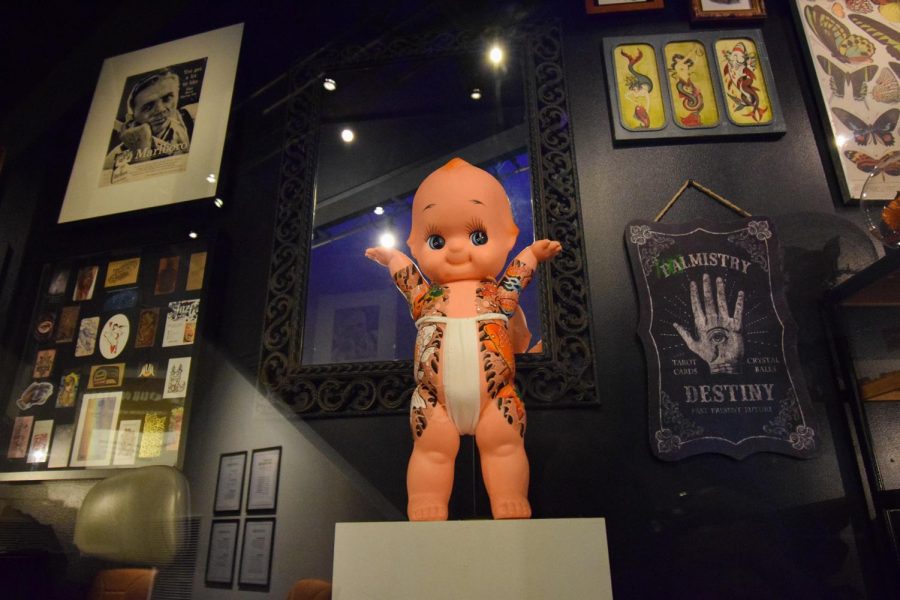Making a Mark: The Evolution of Seattle’s Tattoo Culture
The beloved Japanese Kewpie doll gets inked for the ‘Body of Work’ MoPop exhibit.
Coming from the Tahitian word, tatau, which means “to strike,” tattoos have emerged, evolved, and expanded from earlier forms to become the masterpieces and works of art we see in contemporary cultures today. They have served as expressions of self, marks of protection, symbols of status, fashion statements, and even forms of punishment. In Seattle, the birthplace of grunge and home to many who refuse to follow the crowd, tattoo culture has grown into something that also cannot be contained in a box or under a single label.
America’s Oldest Tattoo Parlor and the Old Days
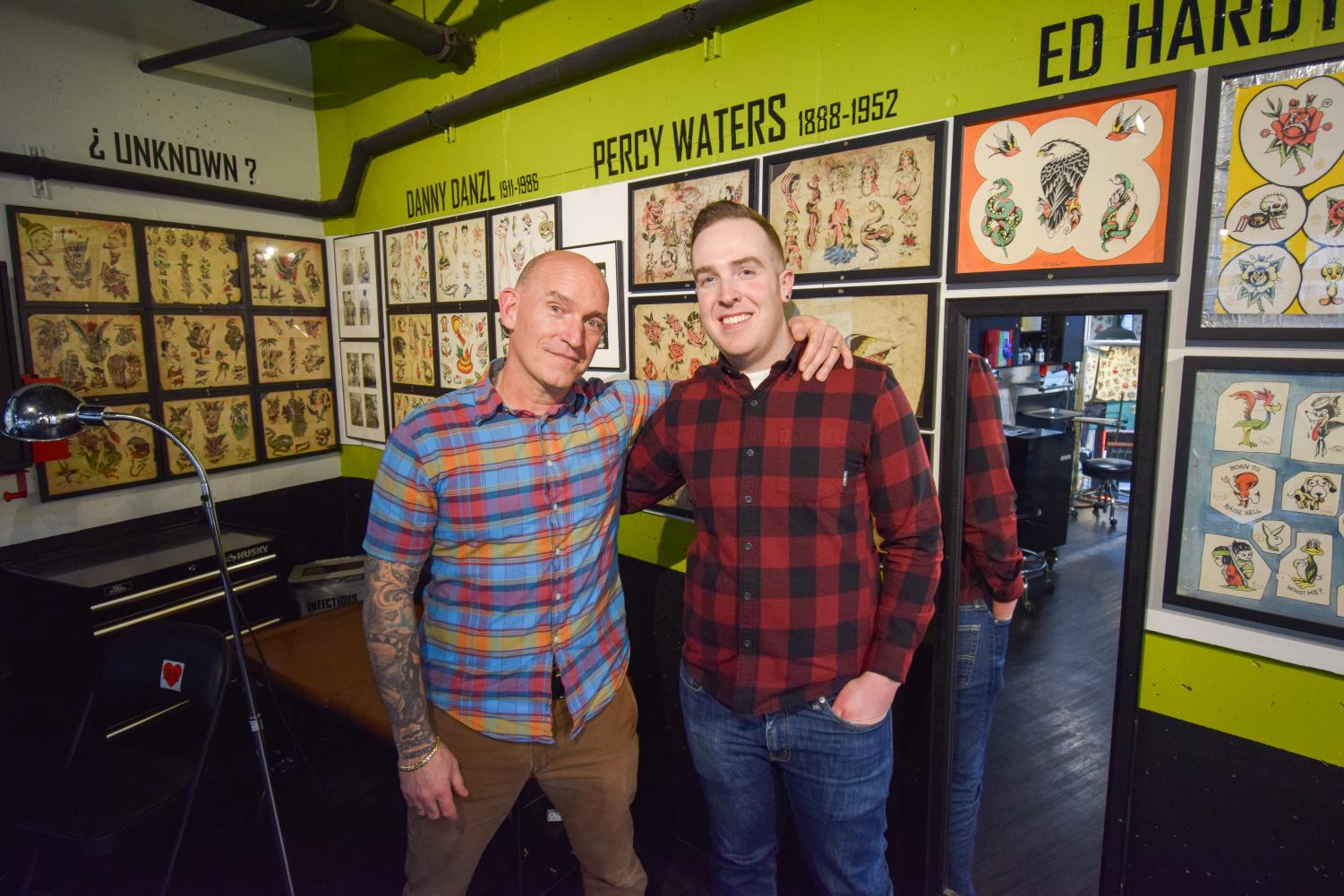
Having had his first tattoo done at the age of eight, Jimmy Hillary, also known as “Jimmy the Saint,” has always had an interest—–obsession—–with tattoos. He arrived in Seattle in 1989 and apprenticed under experienced artist Dennis Dwyer. As the current owner of the Seattle Tattoo Emporium, the oldest tattoo parlor in the city and in the country, Hillary has accumulated almost 32 years of tattoo experience.
Growing up in Barrio El Hoyo in Tucson, Arizona with his father, who was also a tattoo artist, Hillary was amazed by the fine-line, single needle tattoos of the Mexican ex-convicts in his community, which he compared to black lace that had a faded green quality. “It gave me chills whenever I saw it,” he said. “You couldn’t pick apart the separate designs– it covered the whole arm and I just love that look.”
When he took over the Emporium in 2017, Hillary discovered old tattoo flash art left behind by tattoo artists that had come and gone— some pages dating back over 100 years. He decided to revamp the venue and display the flash to inspire his colleagues and share the shop’s rich history with clients. “We tried to give the shop a new image and remind people how great it is that we have something so old in this town where everything gets torn down,” Hillary said.
In 1941, Clarence J. “Danny” Danzl established Seattle Tattoo, which is now Seattle Tattoo Emporium. Before this, he had joined the U.S. Navy where he tattooed fellow sailors, which inspired him to continue the practice in small rented spaces in Seattle’s Skid Row. After World War II and the Great Depression, tattooing in the city had slowed so much that Danzl’s shop was one of the only parlors left.
As tattooing regained popularity and began to take off throughout the decades, famous tattooists, such as Ed Hardy and Sailor Jerry, made their mark at the Emporium and turned the tattoo industry on its head.
One such Seattle-based artist is Vyvyn “Madame” Lazonga, who is considered by many as “Seattle’s First Lady of Tattoo.” Lazonga first walked into Danzl’s shop in 1972, looking to begin her tattooing career. In the 70s, they were considered quite the anomaly, individually and as a duo. From there, Lazonga began creating new styles and flash creations that had not existed before, especially with women in mind. She recalls mixed reactions to her as a female tattoo artist who was heavily tattooed. “They didn’t know how to pigeon-hole me,” Lazonga said.
From male artists ignoring her in shops to people admiring her as a role model to peers projecting prejudiced preconceptions onto her, she persevered and stayed true to her art.
“I never thought about anything except my vision of what I wanted to do in the world of tattooing,” Lazonga said. “I had to learn how to protect myself against that kind of prejudice and scrutiny from the public.”
Throughout her expertise as a mistress of the needle, Lazonga had the honor of working with and befriending legendary artists. Moreover, she also had the chance to be tattooed by many of them. In the 70s, she got three phoenixes tattooed by Ed Hardy.
“It was meaningful for me because I think living life is discovering who you are and in order to do that, you have to go through many different kinds of deaths, psychologically,” she said. “We all go through it.”
In looking at tattoo culture then and now, Lazonga emphasizes the importance of hard work, integrity, and passion in knowing and, more importantly, understanding the craft. This includes learning about machinery, knowing how to make needles and mixing up ink. “There’s something to be said about earning what you do through hard work and learning the craft and what goes into making it a good craft,” she said.
“Body of Work”at the MoPop
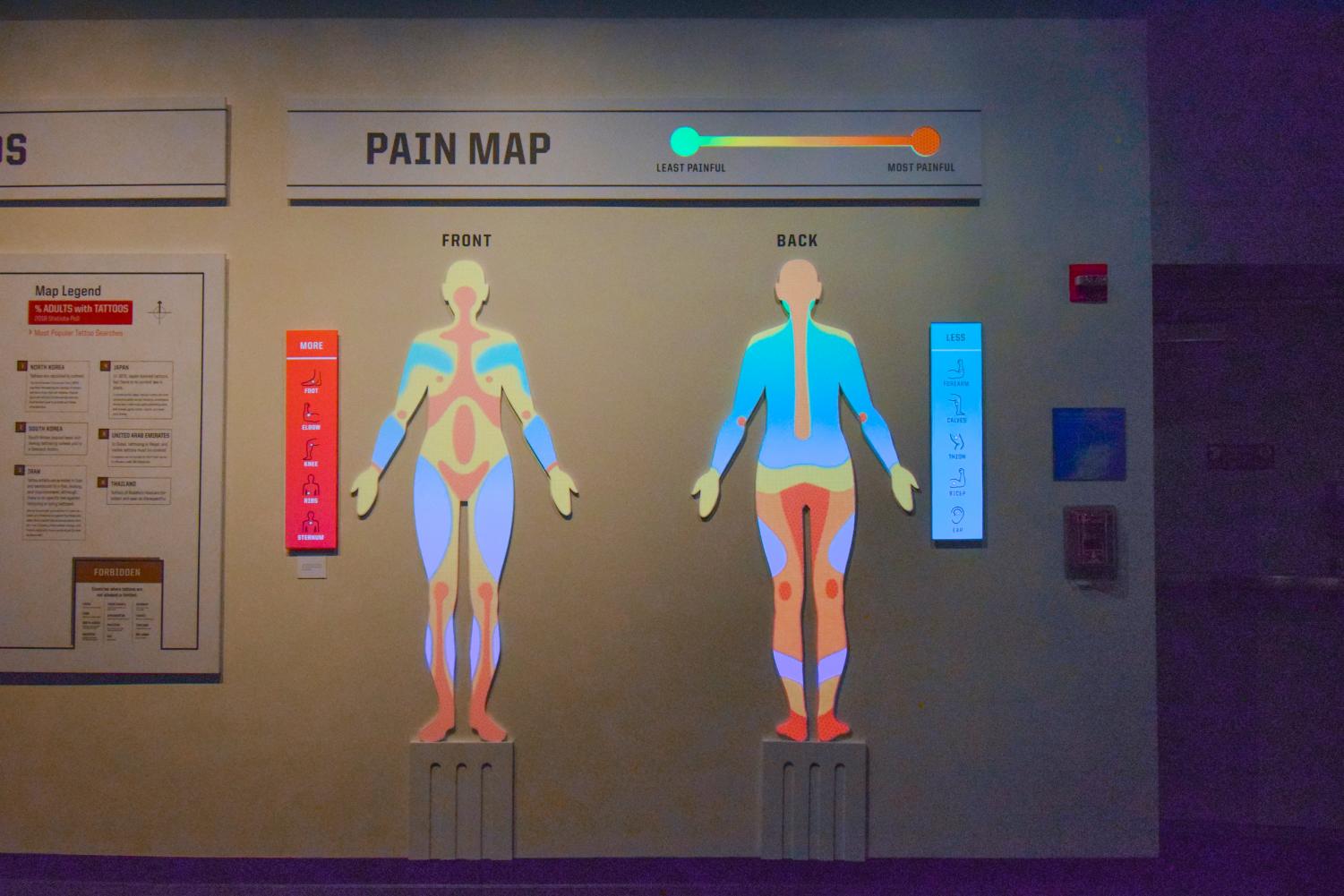
At the beginning of this month, the Museum of Pop Culture (MoPop) released their newest exhibit, “Body of Work: Tattoo Culture,” which explores the roots and evolution of tattoo culture in North America, specifically in the Pacific Northwest.
A primary catalyst in the explosion of tattooing has been social media, specifically Instagram. Amalia Kozloff, a co-curator of the exhibit, explained that because tattooing has so rapidly increased in popularity and demand in the past decade, the MoPop wanted to explore this newer aspect of popular culture in the community.
“Body of Work” begins by exploring tattoo practices and significance in Coast Salish tribes. Sasha LaPointe, a writer, poet, and artist of the Nooksack and Upper Skagit tribes, curated stories of tattoos with significant personal and communal meanings: a Tulalip elder with patterns of mountains on her wrist; Tania Larsson of the Gwich’in tribe in which women tattoo lines in the centers of their chins, symbolizing beauty and status; young Salish women receiving tattoos of circles at the beginning of puberty as signs of protection; LaPointe’s own ancestor using blackberry ink and quills to push circles into her skin; and an elder with his initials marked on his hand to remind him who he is.
LaPointe did note that despite discovering these stories during her research, the Coast Salish tribes were not as focused on tattooing as other tribes in the greater region. If they had been, those practices are essentially lost due to colonization and assimilation into white culture enforced through boarding schools.
A main goal of the MoPop exhibit is to make visitors feel like they are walking into a tattoo shop. The soundtrack playing throughout consists of songs that the commissioned artists themselves enjoy listening to while they tattoo clients. There are also the tapping sounds effects of the traditional rake and strike method and what some artists call “walla,” the murmuring of indistinct voices.
There are 11 tattoo artists who were selected and featured to reflect the wide diversity of styles and people in the industry across the Pacific Northwest.
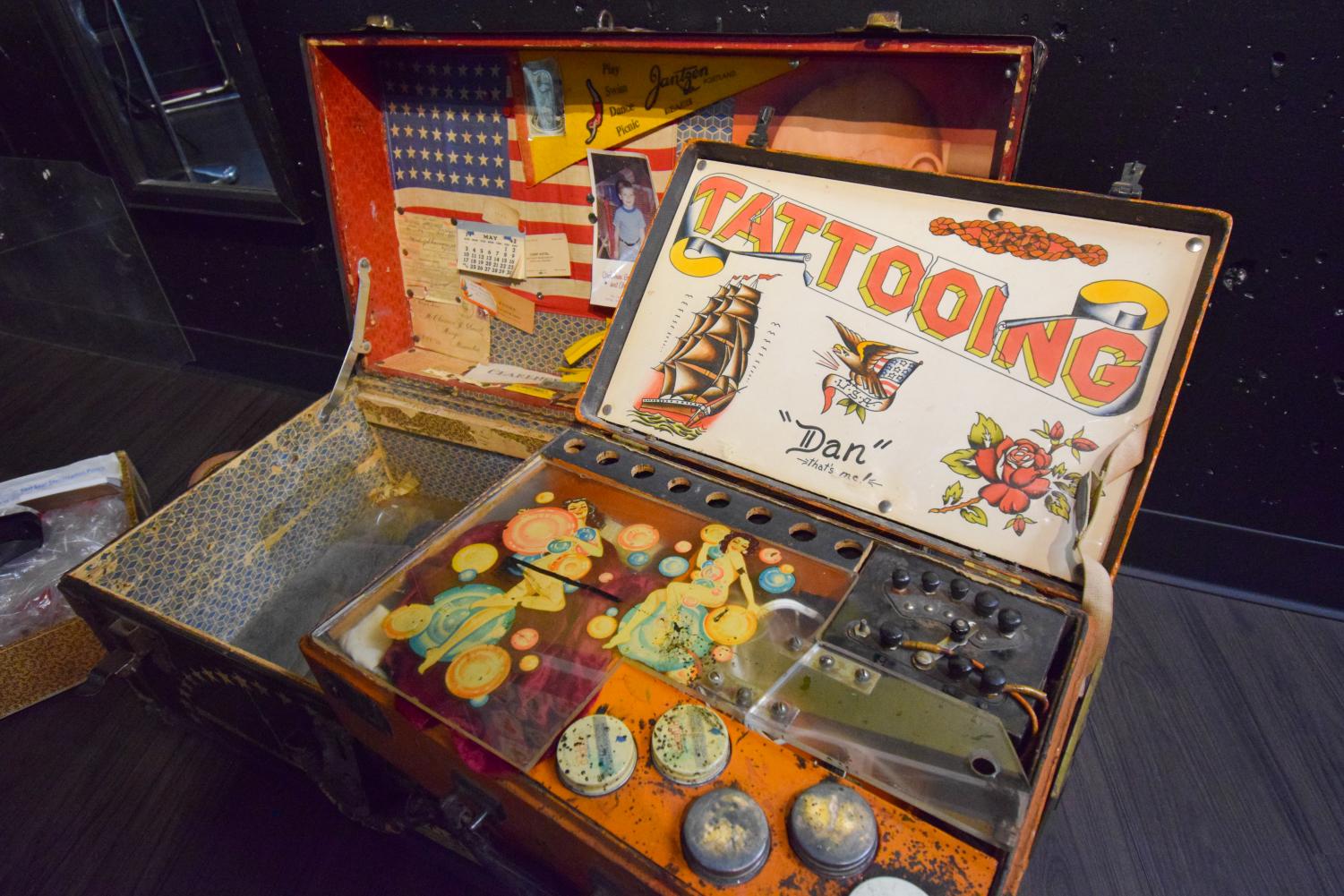
“We really wanted to showcase contemporary artists and show what’s going on in the artform right now and how innovative it is, how inclusive it is, how diverse it is. Everybody should be able to walk into our exhibit and see themselves represented somewhere,” Kozloff said.
Free-standing metal displays run through the exhibit, featuring the works and biographies of each artist. Their works are blown up next to the bios, but also displayed in a tactile panel so that visitors with visual impairments can still experience the pieces. The raised lines of the images can also represent the raised nature of lines on the skin in a new tattoo. In the metalwork of the structures, patterns of dots are based on the different needle arrays of a tattoo artist’s pen. As a whole, the metal displays are meant to imitate partitions in the exhibit space, reflecting the private and public atmosphere found in tattoo parlors.
Featured artists include Aaron Bell and Damon Conklan, renowned innovators that have been in the industry for 20 to 30 years and other new cutting-edge artists, such as Nomi Chi, Dustin Burt and Lolli Morlock, also known as “Lollipop.”
Morlock creates whimsical, colorful, and oftentimes delightfully provocative pieces, finding inspiration from her colleagues, her own background in music in the band Mommy Long Legs, and more importantly, her clients.
“That’s amazing that I get to permanently mark [clients’] bodies and they trust me with that. It’s such an honor,” she said.
Her artwork calls on a sense of humor as an outlet to heal from trauma and a tumultuous childhood, but also serves as an homage to her support system. In her artist’s display, she points out that the whimsical characters depicted are representations of her close friends and fellow tattoo artists who are also portrayed in an accompanying printed zine.
Each artist is featured and honored in a way that focuses on their unique styles and personalities.
“All of these artists are amazing and just blow you away with what they can do. And not just what they can do,” Kozloff said. “Part of this was what they could do beyond tattooing– to show that they are true artists in every sense of the word.”
Another goal of the exhibit is to guide visitors in deciding whether they are ready for a tattoo themselves and if so, what styles work best for their own personal preferences and bodies. First, visitors learn about the step-by-step process of getting a tattoo. Then they move down the wall to watch a time-lapse video of Aaron Bell giving a man a full arm sleeve of tattoos– the entire hours-long process was condensed into mere minutes! From there, the exhibit also has specimen boxes with tattooing equipment, a pain map that shows the least to most painful body parts to tattoo, and a recreation of a tattoo shop.
“We wanted to make sure that everybody could see themselves here and see that there was a place for them,” Kozloff said. “If you want to get a tattoo, there’s a studio for you, there’s an artist for you.”
Tattoo Taboos
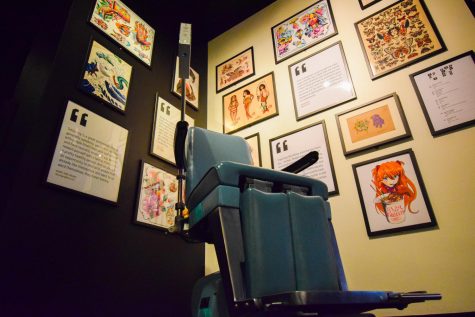
In the ‘Body of Work’ exhibit at the Museum of Pop Culture, a recreation of a tattoo parlor allows visitors to try on hologram designs.
For the most part, as result of self-liberation movements and the prevalence of tattooing on social media, tattoos today have become widely accepted as a medium of storytelling or self-representation. However, this was not always the case as tattoos could prevent an individual from being perceived as a professional or respectable citizen. In the earlier periods of tattoo culture in North America, tattoos were historically associated with criminals, military service members, sailors, and even prostitutes. The nature of tattoos were considered scandalous in the West for a large majority of the 19th century and of course, these attitudes applied to tattoo artists as well.
When Hillary first applied for a home loan at the age of 21, he recalls having to cover all of his visible tattoos and writing his occupation down as a graphic artist rather than a tattoo artist. During the time, it was difficult and nearly impossible for an individual with tattoos to rent an apartment or store front, or obtain a bank loan or credit card. Fast forward to a few years ago when he went in for a refinance and found that banks were practically throwing money at him because tattooing had become one of the fastest-growing businesses in America.
“”I like the change– I’m glad things didn’t just stay the same,” Hillary said.
As an attorney and law professor at Seattle U, Kelli Rodriguez Currie has also found that professional settings in Seattle are largely tattoo-friendly. While appearing in court, she does not feel the need to completely cover every tattoo, yet does note that some judges may not be as accepting as others. In an academic setting, she believes that her tattoos may help students relate to her. “I find that from a student perspective, I think students find it to be a sign of being more approachable,” she said.
Tristan Anslyn, a senior photography major with over 20 tattoos, also feels his tattoos will not affect his opportunities to obtain jobs after graduation. When he works photography jobs at any level, Anslyn emphasizes the importance of being confident in one’s skills and capabilities. “I’m being confident and I’m being the person they actually want to hire, so regardless of my tattoos, you have to sell yourself,” Anslyn said. “Just go get that job, be confident.”
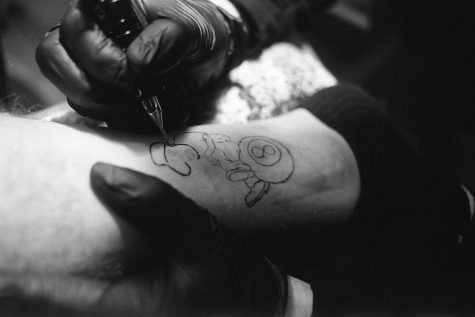
Tattoo artists can use a variety of needles and machines to tattoo clients.
Tattoo You
At the end of the day, tattoos are about the client, the individual, about you. Some of the most common pieces of advice are to find a piece that you want and to get to know your artist. When clients and artists are able to have candid, honest conversations to go back and forth on a piece, the client is able to express what image and what style they want while artists can guide them on how to make the tattoo even better from there. Taking the time to research artists, styles, and other works may be what it takes to find the tattoo waiting out there for you.


